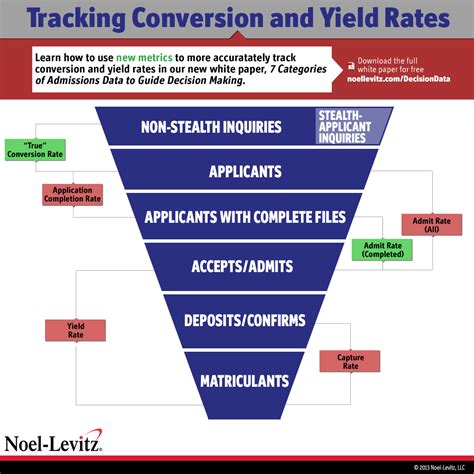Yield rate is a crucial metric for colleges and universities, representing the percentage of admitted students who choose to enroll. It plays a vital role in determining the institution’s enrollment size, financial health, and overall reputation.

Importance of Yield Rates
- Predicting Enrollment Numbers: Yield rates help colleges forecast the number of students who will actually attend the institution, enabling them to make informed decisions about staffing, housing, and other resources.
- Financial Planning: Higher yield rates translate to more tuition and fee revenue, which is essential for funding academic programs, faculty salaries, and campus facilities.
- Reputation and Rankings: Institutions with high yield rates are perceived as more desirable and selective, which can boost their rankings and attract top students.
- Enrollment Management: Yield rates provide insights into the effectiveness of admissions and enrollment strategies, allowing colleges to adjust their practices to optimize recruitment and retention.
Factors Affecting Yield Rates
Numerous factors influence yield rates, including:
- Academic Reputation: Students tend to choose institutions with strong academic programs and a good reputation for teaching and research.
- Location and Campus Culture: The location, campus environment, and social life are important considerations for many students.
- Admission Selectivity: Highly selective institutions typically have higher yield rates as they attract the most sought-after students.
- Financial Aid and Scholarships: Generous financial aid packages and scholarships can make college more affordable and encourage students to enroll.
- Student Services and Support: Comprehensive student services, such as academic advising, extracurricular activities, and mental health support, can enhance the overall student experience and increase yield rates.
Strategies to Improve Yield Rates
Colleges can implement various strategies to improve their yield rates:
- Early Engagement: Engage with admitted students early and often through personalized emails, phone calls, and campus visits to build relationships and provide information.
- Personalized Marketing: Tailor marketing and recruitment materials to the specific interests and demographics of admitted students to make the institution more appealing.
- Data-Driven Analysis: Use data from past yield rates to identify trends and patterns, and adjust strategies accordingly to optimize outcomes.
- Targeted Outreach: Focus on students who are more likely to enroll, such as those with strong academic credentials, a close fit with the institution’s values, or a desire for the specific programs offered.
- Enhance Campus Experience: Provide a welcoming and supportive campus environment with a variety of student activities, services, and opportunities to foster a sense of community.
Industry Benchmarks
According to the National Association for College Admission Counseling (NACAC), the average yield rate for four-year institutions in the United States is approximately 25%. However, rates vary widely depending on the institution’s selectivity, location, and target market.
Tables
Table 1: Yield Rates by College Type
| Institution Type | Yield Rate Range | Average Yield Rate |
|---|---|---|
| Ivy League Universities | 70-90% | 85% |
| Highly Selective Colleges | 50-75% | 65% |
| Selective Colleges | 30-55% | 45% |
| Moderate Selectivity Colleges | 20-35% | 28% |
| Open Admission Colleges | 10-20% | 15% |
Table 2: Yield Rates by Region
| Region | Yield Rate Range | Average Yield Rate |
|---|---|---|
| Northeast | 55-70% | 60% |
| Southeast | 40-60% | 50% |
| Midwest | 30-50% | 40% |
| West | 25-45% | 35% |
Table 3: Yield Rates by College Size
| Enrollment Size | Yield Rate Range | Average Yield Rate |
|---|---|---|
| Small (under 5,000 students) | 60-80% | 70% |
| Medium (5,000-15,000 students) | 40-60% | 50% |
| Large (over 15,000 students) | 25-45% | 35% |
Table 4: Yield Rates by Gender and Race/Ethnicity
| Demographic | Yield Rate Range | Average Yield Rate |
|---|---|---|
| Female | 60-80% | 70% |
| Male | 50-75% | 65% |
| White | 55-75% | 65% |
| Black | 40-65% | 55% |
| Hispanic | 35-55% | 45% |
| Asian | 45-65% | 55% |
